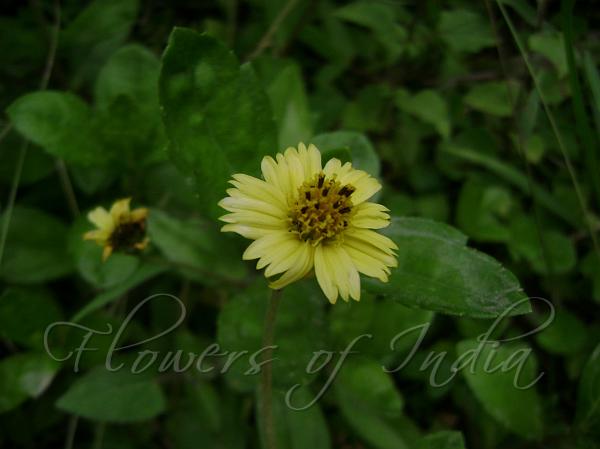|
| Chinese Wedelia |
|

|

| File size | 271205 |
| Original date | 5/22/07 2:30 PM |
| Resolution | 2592 x 1944 |
| Flash | Flash did not fire, auto |
| Focal length | 5.8mm |
| Exposure time | 1/500s |
| Aperture | 2.8 |
| Focus Distance | |
| Metering Mode | Spot |
| Camera make | SONY |
| Camera model | DSC-S650 |
| Sensor type |
|
|
|
| Photo: Thingnam Girija |
Botanical name: Sphagneticola calendulacea Family: Asteraceae (Sunflower family)
Synonyms: Wedelia chinensis, Complaya chinensis, Solidago chinensis
Synonyms: Wedelia chinensis, Complaya chinensis, Solidago chinensis
Chinese Wedelia is a tender, spreading, and hairy herb, with the branches
usually less than 50 cm long. The leaves are oblong to oblong-lanceolate,
2-4.5 cm in length, and narrowed at both ends. The margins are entire or
obscurely toothed; and both surfaces are covered with sharp-pointed,
appressed, straight, and stiff hairs. The heads are stalked, about 1 cm in
diameter, and yellow. The involucral bracts are oblong-ovate. The ray
flowers are 8-12, spreading, about equal to the bracts, and broad; the disk
flowers number about 20, and are short, narrow, and pointed. The achenes
are nearly cylindric, and hairy.
Medicinal uses: The leaves are used in dyeing grey hair and in promoting
the growth of hair. They are considered tonic, alternative, and useful in
coughs, cephalalgia, skin diseases, and alopecia. The juice of the leaves
is much used as a snuff in cephalalgia. The seeds and flowers, as well as
the leaves, are used in decoction, in the quantity of half of teacupful
twice daily, as a deobstruent. In decoction, the plant is used in uterine
haemorrhage and menorrhagia.
The leaves are used in dyeing grey hair and in promoting
the growth of hair. They are considered tonic, alternative, and useful in
coughs, cephalalgia, skin diseases, and alopecia. The juice of the leaves
is much used as a snuff in cephalalgia. The seeds and flowers, as well as
the leaves, are used in decoction, in the quantity of half of teacupful
twice daily, as a deobstruent. In decoction, the plant is used in uterine
haemorrhage and menorrhagia.
Medicinal uses:
 The leaves are used in dyeing grey hair and in promoting
the growth of hair. They are considered tonic, alternative, and useful in
coughs, cephalalgia, skin diseases, and alopecia. The juice of the leaves
is much used as a snuff in cephalalgia. The seeds and flowers, as well as
the leaves, are used in decoction, in the quantity of half of teacupful
twice daily, as a deobstruent. In decoction, the plant is used in uterine
haemorrhage and menorrhagia.
The leaves are used in dyeing grey hair and in promoting
the growth of hair. They are considered tonic, alternative, and useful in
coughs, cephalalgia, skin diseases, and alopecia. The juice of the leaves
is much used as a snuff in cephalalgia. The seeds and flowers, as well as
the leaves, are used in decoction, in the quantity of half of teacupful
twice daily, as a deobstruent. In decoction, the plant is used in uterine
haemorrhage and menorrhagia.| Identification credit: Akramul Hoque | Photographed in Imphal, Manipur. |
• Is this flower misidentified? If yes,